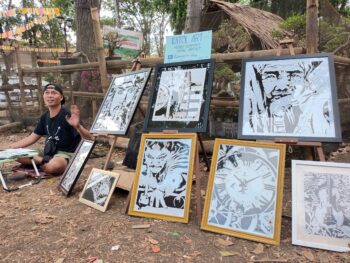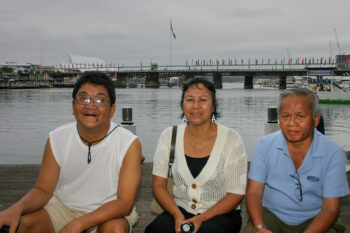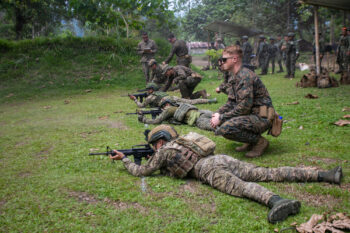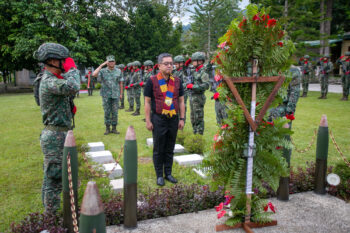DAVAO CITY (MindaNews/13 August) — When I was a kid, I already used to travel a lot with my father between Cotabato City and Koronadal. Although my memories are quite vague, I could remember a few landmarks between the 76-kilometer Cotabato City-Isulan highway since this is the shortest and probably the safest route during the 80s to the 90s.
During Christmas, we would visit Koronadal for a family gathering then travel back to Pigcawayan in North Cotabato. The most common means of reaching Isulan from Cotabato City at that time was either by jeep or GD Bus. Then from Isulan, we would ride the Yellow Bus, which employed Isuzu KC Model jeeps.
The fare I think was between P33 and 37. If the jeep went straight to Koronadal City, we would only add P10. But that’s very rare. Some would even shuttle the passengers straight to General Santos City.
Once the jeep left the city proper, I could distinguish that we were already out of the city proper upon seeing the Tamontaka Bridge along the Rio Grande de Mindanao. I knew it is the largest river in Mindanao since my grandfather, who was then an elementary school teacher, would always give me trivia on Mindanao’s geography.
After Tamontaka Bridge, I would know that we were already near the junction of the Awang International Airport because once we passed the compound of the defunct Mindanao Textile (Mintex) in Datu Odin Sinsuat, Maguindanao.
About 30 minutes later, we would be in Dinaig, the old name of Datu Odin Sinsuat. The maroon accents of the Mindanao State University (MSU) buildings reminded me that we were in the heart of Dalican. I could remember a few people selling live dalag (mudfish) near the bridge, adjacent to the MSU campus.
I could not forget Talayan for its lonely town hall that sat on top of the barren hill, which is on the left side going to Isulan. Today, a new town hall stands across the highway. The old town hall is now a police station.
The Crossing Salvo, which is now Datu Saudi Ampatuan, was still part of Maganoy and it is the gateway to one of the oldest towns of Maguindanao: Datu Piang.
There is no landmark here but every time I pass this junction, gun battles would flash in my mind because I have been hearing news on the radio that this place is a battle ground of government forces and Moro Islamic Liberation Front (MILF). This has been a site of ambuscades and encounters. Many of the soldiers from Pigcawayan were killed or wounded in this area.
And of course, military checkpoints are located a few kilometers apart from each other along this national highway.
As the jeep stopped in Maganoy, the old name of Shariff Aguak, the vendors would approach the passengers and offer boiled eggs and roasted peanuts. While the driver or his conductor would pay the arkabala (toll) at the ticket booth.
Two or three trees used to stand in front of the old terminal, now the public market. I think those were felled during the road widening sometime in 2001.
Aside from the regular terminal tickets, I could still remember the jeep driver murmuring that he had to prepare extra P20 for other “ticket booths.” I was too young to understand those things as I grew up and travelled on the same route over and over again, but I eventually learned that the driver was referring to “extortionists.”
I could still remember that those “ticket booths” were located in the national highways where you could only see a few houses. The driver would just quietly drop the P20 into the box and get back to the driver seat. I could barely see the person manning the booth. But that was over 20 years ago along the Cotabato-Isulan highway.
Anyway, aside from landmarks, I could easily distinguish the towns between Cotabato City and Isulan because during those years, there were only four: Datu Odin Sinsuat, Talayan, Maganoy and Ampatuan. After Ampatuan, it’s already Esperanza town of Sultan Kudarat.
In Ampatuan town, I think nothing has changed. I could not remember any landmark that distinguishes the town from the others except for its old town hall on the left side going to Isulan which was painted mint green.
After crossing the Ampatuan-Esperanza boundary, I knew that we were already in Sultan Kudarat province because I could see different types of tricycles locally known as “back to back” type.
A little farther from the town proper, another landmark reminded me that we were already in Sultan Kudarat: the Allah River, which I could recognize from its size and the length of the bridge that spans it.
Today, can you count and name the towns between Cotabato City and Isulan? But that’s another story.
Upon arriving in Isulan, we would take either the Isulan-Koronadal highway passing the towns of Sto. Niño, Surallah and Banga in South Cotabato or the route via Tacurong (Sultan Kudarat) and Tantangan, South Cotabato.
No landmarks can be seen along the Isulan-Koronadal route, except for the vast rice fields and mountains of rice hulls beside several rice mills along the national highway. I could see some people either winnowing at the foot of the towering rice hulls or plowing the rice fields.
This is because the highway is nestled in Allah Valley, the rice granary of South Cotabato that straddles the towns of Surallah, Tboli, Banga, Norala , Sto. Nino and Lake Sebu.
In the past, Surallah’s landmark was its old rotunda, which is already mounted with sculptures by Kublai Milan. His works, which are distributed in the three clusters, are now the new landmarks of the town.
About 15 minutes later on the road, the jeep would start a gradual climb from the boundary of Banga town traversing Roxas Mountain Range.
Upon reaching Barangay Matulas, the sight of the Bishop’s Palace of the Diocese of Marbel would tell me we’re almost in Koronadal. While negotiating down the curves, I could already see the rotunda of Koronadal with the statue of Gen. Paulino Santos facing the national highway leading to the city that bears his name.
As a kid who was still learning to read, landmarks were my travel guide to distinguish the places we were passing by.
Over the years, most of these landmarks have remained in their places, some have changed, while others are already dilapidated.
After the family gathering, we would travel back to Pigcawayan. Sometimes we took the route from Tantangan to Tacurong, where we would ride the jeep back to Cotabato City. It’s quite shorter by about 45 minutes I think compared to the Koronadal-Isulan route.
But in the late 80s, the Koronadal-Tacurong highway was still bumpy and dusty. Irrigation canals across the highways gave a feeling of roller coaster ride due to the size of culverts on the road.
Tantangan was really a sleepy town even in the past. No landmarks, nothing to remember by except for its vast plain.
In Tacurong, which was turned into a component city in 2000, the oil palm plantation of Kenram reminded me that we were already going out of Tacurong.
Then after 28 kilometers of travel, I could see the old statue of Sultan Kudarat that stands on the rotunda of the national highway. Then we would turn right back to Cotabato City.
Back at home, my grandfather would then ask me where I had been and would take out a 3×4-feet Philippine map to show me the roads we traveled. Being a teacher, he would share little history about the towns we passed.
New route opened
About 15 years later, many things have changed along the Cotabato-Isulan national highway. More towns were created I could not name them all without checking the map.
The new town halls are now the new landmarks along this highway. In Shariff Aguak, it is the Ampatuan mansion, no longer the trees because they were replaced by street lamps.
In Crossing Salvo, the landmark is now the rotunda that makes the highway narrower by a few meters.
I could not remember when the M’lang-Tacurong route was opened to public transport. I could not exactly remember too the first time I passed that route. But I think I was already in college when I got to travel it often.
This time, vans reign the route as well as the Cotabato-Isulan highway.
In the past, motorists avoid the M’lang-Tacurong route because it’s pretty “risky.” But then again, that’s another story.
(Next: Landmarks in my mind: the Davao-Cotabato route)
(Keith Bacongco is a reporter of MindaNews. He was born in Koronadal, South Cotabato but grew up with his grandparents in Pigcawayan, North Cotabato. He is now married to a Davaoeña and resides in Davao City)







